Garlic farming in Kenya presents a lucrative opportunity for farmers and entrepreneurs alike. Known locally as ‘Kitunguu Saumu’, garlic has established itself as a valuable horticultural crop in the country, owing to its impressive yields and strong market demand.
Want to grow garlic and don’t even know where to start? I’ll do my best to guide you through, so read on.
Also Read: how to farm bulb onions in Kenya
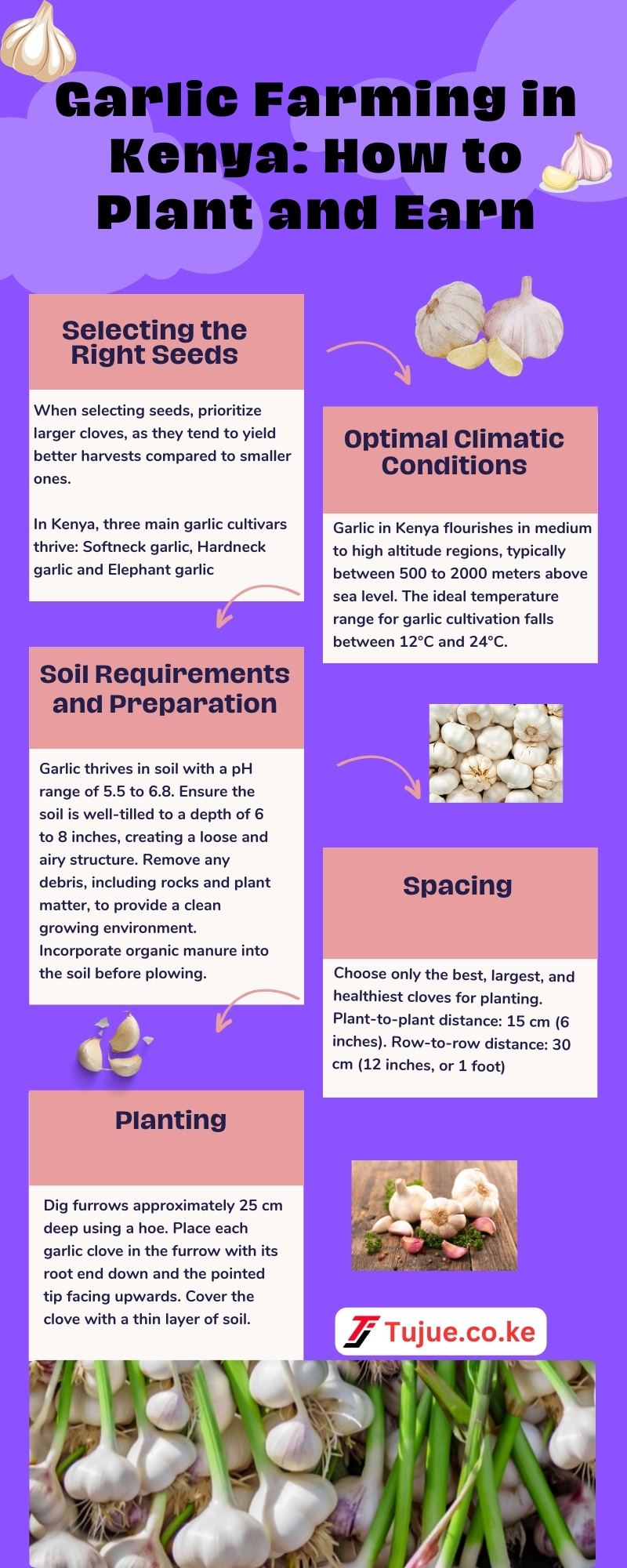
Garlic Farming in Kenya How to Plant and Earn Infographic
Types of Garlic: Varieties Cultivated in Kenya
Kenyan farmers primarily cultivate three main varieties of garlic, each with its unique characteristics and market appeal:
1. Soft-neck Garlic
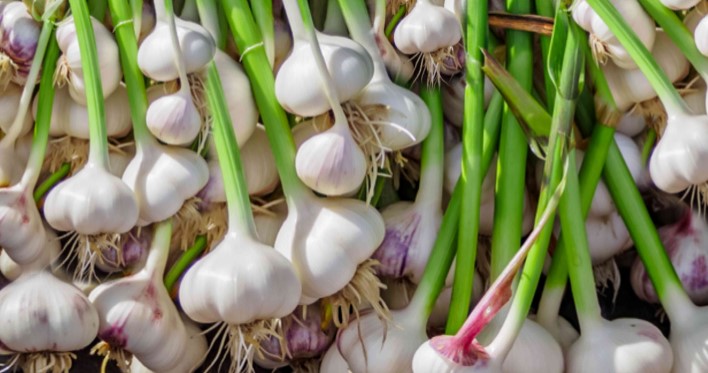
This is the most prevalent variety in Kenyan garlic farming. Characterized by its paper-like, white skin, soft-neck garlic is prized for its ease of cultivation, making it a favorite among local farmers.
Each bulb typically produces a moderate number of large cloves. Soft-neck garlic is known for its intense flavor profile and strong aroma, qualities that are highly valued in the culinary world.
2. Hard-neck Garlic
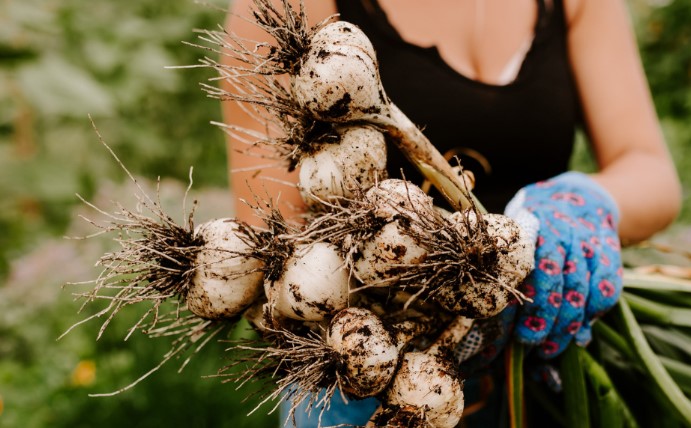
Distinguished by its robust and sweetly aromatic flavor, hard-neck garlic produces fewer but larger cloves per head compared to its soft-neck counterpart.
One of its notable features is the ease with which its skin can be peeled. However, its shorter shelf life makes it less favored in the Kenyan market, where long-term storage capabilities are often crucial.
3. Elephant Garlic
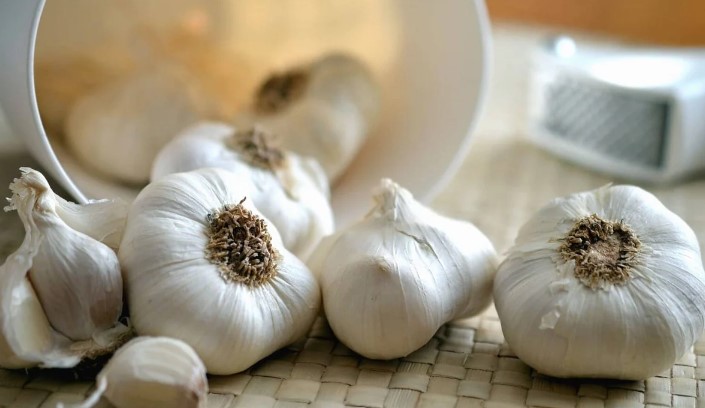
Despite its name, elephant garlic is botanically closer to leeks than true garlic. It’s characterized by its impressively large head composed of enormous cloves. Elephant garlic can often be found in upscale supermarkets and specialty stores. Its mild flavor and subtle aroma make it an excellent choice for dishes where a gentler garlic presence is desired.
How to Grow Garlic in Kenya
Successful garlic cultivation in Kenya requires a deep understanding of local seed varieties, soil suitability, and optimal climatic conditions.
This guide outlines the crucial stages of garlic farming in Kenya, highlighting essential steps and key considerations for prospective garlic farmers.
Selecting the Right Seeds
Garlic propagation relies on seed cloves rather than traditional seeds. To ensure a successful harvest, it’s crucial to source certified garlic seeds with fully developed cloves that are free from any diseases or infections. These can typically be obtained from authorized seed companies or reputable garden supply stores.
When selecting seeds, prioritize larger cloves, as they tend to yield better harvests compared to smaller ones.
In Kenya, three main garlic cultivars thrive:
1. Softneck garlic
2. Hardneck garlic
3. Elephant garlic
Each variety has its unique characteristics and may be suited to different growing conditions or market demands.
Optimal Climatic Conditions
Garlic in Kenya flourishes in medium to high altitude regions, typically between 500 to 2000 meters above sea level. The crop requires specific temperature conditions for optimal growth:
– High temperatures of around 30°C are essential for proper bulb development.
– Cooler temperatures are beneficial during the early stages to promote vegetative growth and plant establishment.
– The ideal temperature range for garlic cultivation falls between 12°C and 24°C.
It’s important to note that excessive rainfall and high humidity can impede both vegetative growth and bulb formation in garlic.
The crop tends to perform better in areas with lower rainfall. In drier regions, irrigation may be necessary, particularly during the early stages when water demand is highest.
Soil Requirements and Preparation
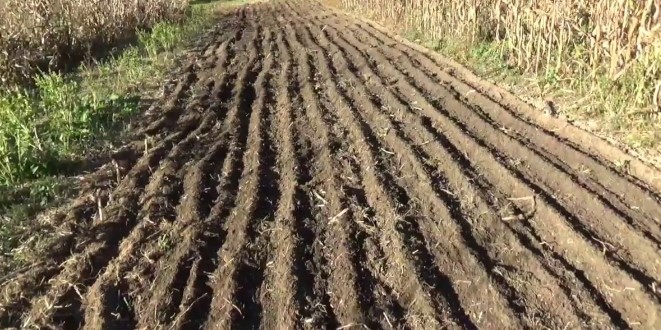
Garlic thrives in soil with a pH range of 5.5 to 6.8. Fortunately, many Kenyan soils fall within this range, making them suitable for garlic cultivation.
However, proper soil drainage is crucial, as garlic performs poorly in waterlogged conditions. Farmers should avoid clay soils whenever possible, as they can restrict bulb growth and development.
To prepare the soil for garlic planting:
1. Ensure the soil is well-tilled to a depth of 6 to 8 inches, creating a loose and airy structure.
2. Remove any debris, including rocks and plant matter, to provide a clean growing environment.
3. Incorporate organic manure into the soil before plowing. This practice enhances soil fertility and promotes better bulb formation, ultimately maximizing yield.
The ideal soil for garlic should be:
– Well-drained
– Loose and friable
– Free from debris
– Enriched with organic matter
Planting and Spacing Guidelines for Garlic Cultivation
Garlic is a relatively straightforward crop to cultivate, but proper planting techniques and spacing are crucial for optimal growth.
Here’s a detailed guide on how to plant garlic effectively:
1. Clove Selection
Choose only the best, largest, and healthiest cloves for planting. This selection process is vital as it directly influences the quality and yield of your harvest.
2. Spacing
Ensure you follow this guideline:
– Plant-to-plant distance: 15 cm (6 inches)
– Row-to-row distance: 30 cm (12 inches, or 1 foot)
3. Planting Process
a) Dig furrows approximately 25 cm deep using a hoe.
b) Place each garlic clove in the furrow with its root end down and the pointed tip facing upwards.
c) Cover the clove with a thin layer of soil.
d) Repeat this process, maintaining the 6-inch spacing between plants.
e) Ensure subsequent rows are spaced 60 cm (2 feet) apart from the preceding ones.
4. Initial Watering
Water the rows lightly, just enough to moisten the soil surface. Be cautious not to overwater, as excessive moisture can cause the seed cloves to rot before sprouting.
Irrigation Management for Garlic Crops
Proper water management is crucial for garlic cultivation, as the crop prefers well-drained soils and is susceptible to overwatering. Here are key points to consider:
1. Soil Preference: Garlic thrives in well-drained soils that don’t retain excessive water.
2. Water Requirements: Garlic generally requires less water compared to many other crops.
3. Mulching: When seeds are covered with mulch, the need for watering is significantly reduced.
4. Supplemental Watering: If there’s been little rainfall, you may need to water the garlic after a few weeks of planting. When watering is necessary:
– Apply water lightly
– Aim for a soil moisture depth of one inch
5. Rainfall Sufficiency: If there’s adequate rainfall every 10 to 14 days, additional watering may not be necessary.
Disease and Pest Control in Garlic Farming
Diseases and pests are common in most crop farming, including rosecoco farming in Kenya. However, by implementing a combination of the following management strategies, you can significantly reduce the impact of onion maggot infestations on your garlic.
It’s important to note that an integrated pest management (IPM) approach, combining multiple control methods, is often the most effective strategy for long-term pest control.
Onion Maggot (Delia antiqua)
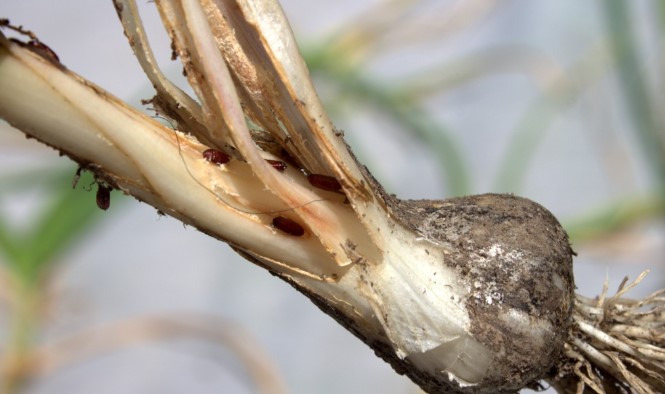
The onion maggot, scientifically known as Delia antiqua, is a serious pest that can cause substantial damage to garlic crops. Understanding its lifecycle, symptoms of infestation, and management strategies is crucial for successful garlic cultivation.
Identification and Lifecycle
1. Adult Insect:
– Appearance: Greyish fly, resembling a small housefly
– Size: Approximately 6-8 mm in length
– Lifespan: 2-4 weeks
– Egg-laying capacity: Females can lay several hundred eggs during their lifetime
2. Eggs:
– Appearance: White, elongated
– Location: Typically laid around the base of the garlic plant
3. Larvae (Maggots):
– Newly hatched: Tiny, white
– Mature larvae: About 1 cm (0.4 in) long
– Distinguishing feature: Presence of feeding hooks
Disease and Pest Management in Garlic Farming
Effective disease and pest management is crucial for successful garlic cultivation in Kenya.
Here are some key strategies:
1. Weed Control
Weeds compete with garlic for nutrients, light, and water, making their control essential.
Methods of weed control include:
– Crop Rotation: Plant garlic in areas that haven’t had garlic or onion crops for an extended period.
– Manual Hoeing: Physical removal of weeds.
– Mulching: Suppresses weed growth and conserves soil moisture.
– Cultivation: Tilling the soil to disrupt weed growth.
– Herbicide Application: Chemical control of weeds (use with caution and follow local regulations).
2. Pest Management
Use copper oxychloride and other soil fumigants to reduce and eliminate nematodes in the field. Implement Integrated Pest Management (IPM) strategies to minimize chemical use while effectively controlling pests.
Note: Always consult an expert for the right strategies
3. Disease Prevention:
– Practice proper crop rotation to break disease cycles.
– Use disease-resistant garlic varieties when available.
– Ensure good air circulation by maintaining proper plant spacing.
– Avoid overwatering, as wet conditions can promote fungal diseases.
How Profitable is Garlic Farming in Kenya
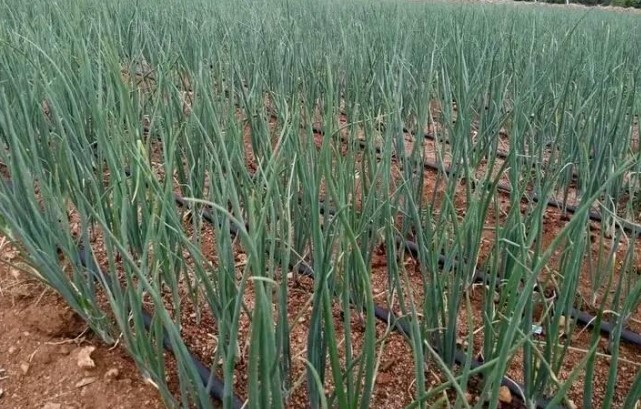
Garlic’s value fluctuates seasonally, reaching its peak during the months of May through September.
During this high-demand period, farmers can expect to sell their garlic for an impressive KSh. 300 to KSh. 400 per kilogram. The market experiences a slight dip from December to January, with prices settling between KSh. 150 to KSh. 200 per kilogram.
Analyzing Garlic Farming Profit Per Acre
To put the profit potential into perspective, let’s consider the yield and market prices.
With an acre of land producing between 4,000 to 5,000 kilograms of garlic, and assuming a conservative selling price of KSh. 150,000 per ton (or KSh. 150 per kilogram), farmers can potentially generate an impressive income ranging from KSh. 600,000 to KSh. 750,000 per acre. However, during peak demand periods when prices can reach up to KSh. 400 per kilogram, the potential revenue could soar to between KSh. 1,600,000 to KSh. 2,000,000 per acre.
It’s important to note that these figures represent gross income, and farmers should account for production costs such as inputs, labor, and transportation when calculating net profit. Nevertheless, even after considering these expenses, garlic farming remains a highly attractive option for Kenyan agriculturists looking to maximize their land’s earning potential.
Note: It’s noteworthy that despite these price fluctuations, industry experts predict that the price of garlic is unlikely to fall below KSh. 150 per kilogram in the foreseeable future, providing a stable income floor for farmers.
How Long Does Garlic Take to Grow in Kenya?
The growth cycle of garlic in Kenya typically spans 4 to 5 months from planting to harvest, making it a relatively quick crop for farmers to cultivate.
This timeframe can vary slightly depending on local climate conditions, soil quality, and the specific garlic variety planted.
As the garlic matures, farmers should be attentive to several key indicators that signal the approaching harvest time:
1. Leaf coloration: The green leaves of the garlic plant will gradually begin to turn brown, starting from the bottom of the plant and progressing upwards.
2. Bulb development: Farmers can gently excavate around a sample bulb to assess its readiness. Harvest-ready garlic will display clearly defined clove ridges and have reached a substantial size.
3. Partial leaf die-back: When some of the leaves have withered and died back, but not all, it’s typically an optimal time for harvest.
Note: It’s crucial not to delay harvesting until all leaves have completely died back, as is common practice with onions. Waiting too long can result in the garlic bulbs splitting, which, while still edible, may reduce their long-term storage potential. Bulbs that have begun to split should be earmarked for immediate use.
Post-harvest handling is critical for maintaining garlic quality. Excess soil should be gently shaken or brushed off, taking care not to bruise the bulbs. Rough handling, such as banging bulbs together or against hard surfaces, can significantly reduce their storage life.
What Regions Do Best in Garlic Farming
While garlic is generally considered a cool-season crop, the specific planting times can vary across the country. It’s important to note that these recommendations primarily apply to rain-fed farming practices.
This crop does well in:
– Highland Regions (e.g.Central Rift Valley, Nandi Hills): May to August planting season
– Coastal Regions (e.g., Mombasa, Malindi): June to August planting season
– Eastern and Northern Regions (e.g., Machakos, Kitui, Isiolo): October to December (short rainy season)
Happy Farming!
Garlic farming in Kenya presents a compelling opportunity for both small-scale and commercial agriculturists. With its relatively short growing cycle of 4-5 months, adaptability to various regions, and high market demand, garlic has emerged as a lucrative crop in the Kenyan agricultural landscape.
The key to success in garlic farming lies in understanding and adapting to regional climate patterns, implementing good agricultural practices, and timing harvests to align with peak market demands. With proper planning, cultivation techniques, and market strategies, you can tap into this golden opportunity!

